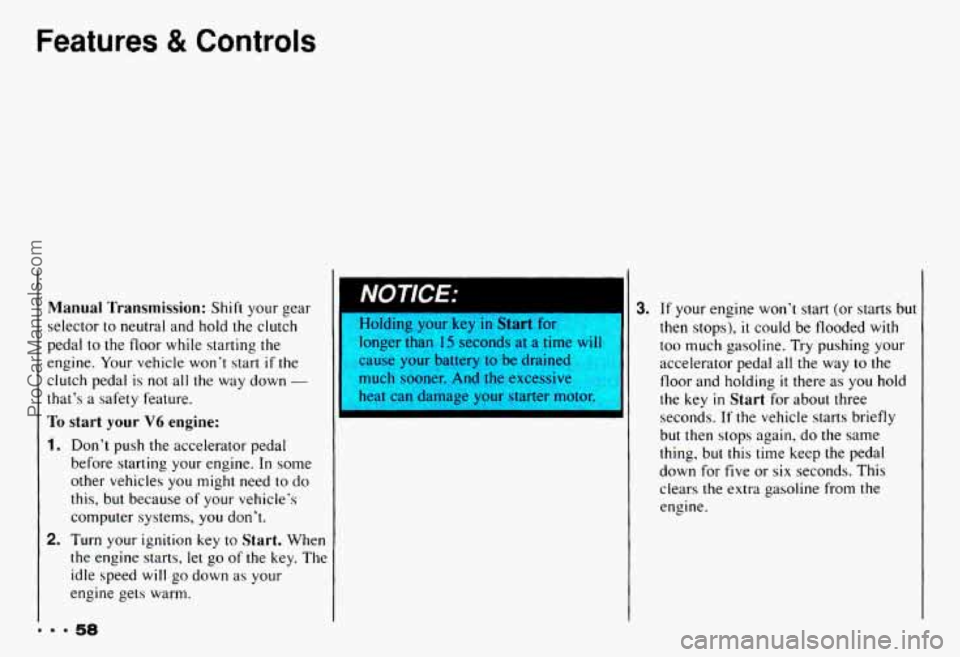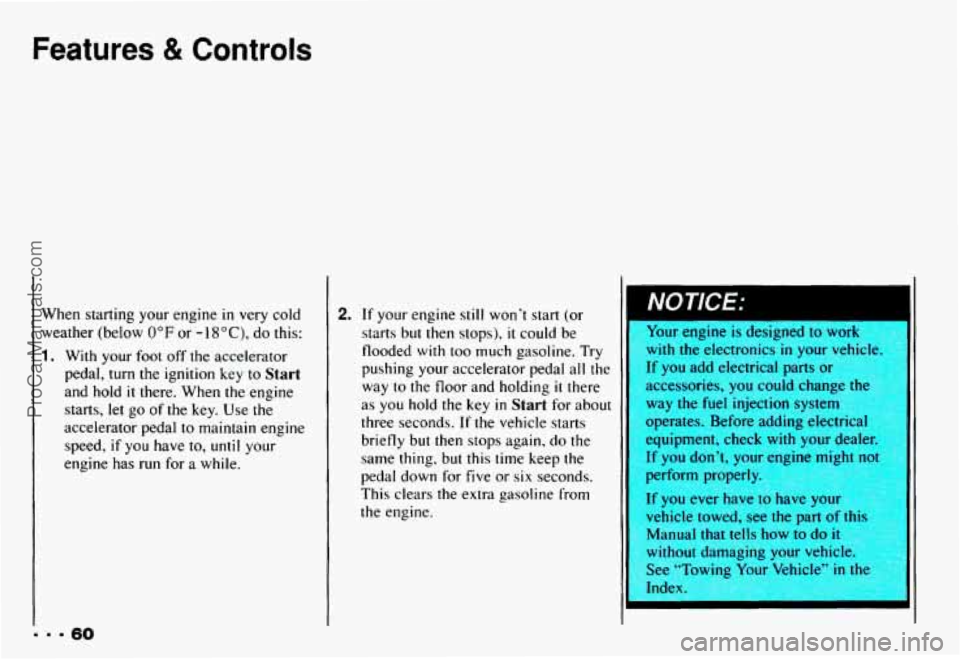Page 57 of 358

When you park your Chevrolet and open
the driver’s door, you’ll hear a tone
reminding you to remove your key from
the ignition and take
it with you. Always
do this. Your steering wheel
will be
locked, and
so will your ignition. If you
have an automatic transmission, taking
your key out also locks your transmission.
And remember to lock the doors.
Parking at Night: Park in a lighted spot,
close all windows and lock
your vehicle.
Remember
to keep your valuables out of
sight. Put them in a storage area, or take
them with you.
Parking Lots: If you park in a lot where
someone will be watching your vehicle,
it’s best to lock it up and take your keys.
But what if you have to leave your
ignition key? What
if you have to leave
something valuable
in your vehicle?
0 Put your valuables in a storage area,
like your glove box.
0 Lock the glove box.
0 Lock all the doors except the driver’s.
Then take the door key with you.
,I
Your vehicle is equipped with the
PASS-Key II@ (Personalized Automotive
Security System) theft-deterrent system.
PASS-Key II@ is
a passive theft-deterrent
system. This means you don’t have to do
anything different to arm or disarm the
system. It works when you insert or
remove the ke from the ignition.
PASS-Key I1 uses
a resistor pellet in
the ignition key that matches a decoder
in your vehicle.
When the PASS-Key
II@ system senses
that someone is using the wrong key,
it
shuts down the vehicle‘s starter and fuel
systems.
For about three minutes, the
starter won’t work and fuel won’t
go to
d
53-
ProCarManuals.com
Page 58 of 358

Features & Controls
the engine. If someone tries to start your
vehicle again or uses another key during
this time, the vehicle
will not start. This
discourages someone from randomly
trying different keys
with different
resistor pellets
in an attempt to make a
match.
The ignition key must be clean and dry
before it’s inserted
in the ignition or the
engine may not start. If the engine does
not start and the
SECURITY light stays
on when you try to start the vehicle, the
key may be dirty or wet. Turn the
ignition off.
Zlean and dry the key. Wait about three
ninutes and try again. The
SECURITY
ight will remain on during this time. If the
starter still won’t work, and the key
appears to be clean and dry, wait about three minutes and
try the other ignition
key.
At this time, you may also want to
check the fuses (see “Fuses and Circuit
Breakers”
in the Index). If the starter
won’t work with the other key, your
vehicle needs service. If your vehicle
does start, the first ignition key may
be faulty. See your Chevrolet dealer
or a locksmith who can service the
PASS-Key
II@.
[f you accidentally use a key that has a
lamaged or missing resistor pellet, the
;tarter won’t work and the security light
will flash. But you don’t have to wait
hree minutes before trying one of the
Ither ignition keys. See your Chevrolet
dealer or a locksmith
who can service the PASS-Key II@ to
have a new key made.
If you’re ever driving and the
SECURITY light comes on and stays on,
you
will be able to restart your en ine if
you turn it off. Your PASS-Key I1 %
;ystem, however, is not working properly
md must be serviced by your Chevrolet lealer. Your vehicle
is not protected by
:he PASS-Key 11’ system.
:f you lose or damage a PASS-Key 11’
gnition key, see your Chevrolet
lealer or a locksmith who can service
’ASS-Key 11’ to have a new key made.
ProCarManuals.com
Page 59 of 358
Off (C): Unlocks the steering wheel,
ignition and automatic transmission, but
does not send electrical power to any
accessories. Use this position
if your
vehicle must be pushed or towed.
A
warning tone will sound if you open the
driver’s door when the ignition is
in Off
and the key is in the ignition.
Run (D): Position to which the switch
returns after you start your engine and
release the switch. The switch stays
in the
Run position when the engine is running.
But even when the engine is not running,
you can use
Run to operate your
electrical power accessories and to
display some instrument panel warning
and indicator lights.
ProCarManuals.com
Page 60 of 358
Features & Controls
Start (E): Starts the engine. When the
engine starts, release the key. The ignition
switch will return
to Run for normal
driving.
Note that even if the engine is not
running, Acc and Run allow you to
operate your electrical accessories. such
as the radio and ventilation fan.
Key Release Button: I1 you have a
manual transmission, your ignition lock
has a key release button. You must press
the button before you can take
your key
out of the ignition lock.
On manual transmission
1 vehicles, turning the key to
LOCK will lock the steering
column and result
in a loss of ability
to steer the vehicle. This could
cause a collision.
If you need to turn
the engine
off while the vehicle is
moving,
turn the key only to Off.
Don't press the key release button
while
the vehicle is moving.
... 56
ProCarManuals.com
Page 61 of 358

I
rn
1
I
I
NOTICE:
I. If your key seems stuck in LOCK 1
and you can’t turn it, be sure it is all 5
the way in. If it is, then turn the
steering wheel left and right whil
you turn the key hard. But turn
tt
key only with your hand. Usir
tool
to force it could break the key
or
the ignition switch. If none of thi:
works,
then your vehicle nvAr
service.
T
i
ietained Accessory Power (RAP)
f you have power door locks, your
lehicle
has a feature called Retained
kcessory Power (RAP). With RAP your power
door locks, electric mirrors, power
windows, audio system and remote hatch
release will continue
to work up to 10
minutes after the ignition key is turned to
Off and neither door is opened.
If a door is opened, the audio system and
power windows will shut off. The power
door locks, electric mirrors and remote
hatch release will work
until you shut the
door. Once you have shut the
door, these
accessories
will continue to work for
approximately
35 seconds. After this
time you
will not be able to use these
accessories
until the next time you open
a
door or turn on the ignilion.
Starting Your Engine
Automatic Transmission: Move your
shift lever to P (Park) or N (Neutral).
Your engine won’t start
in any other
position
- that’s a safety feature. To
restart when you’re already moving,
use
N (Neutral) only.
NOTICE: I
Don‘t try to shilt to P (Park) if your
Chevrolet is moving.
If you do, vou
could damage the transmission,
Shift
to P (Park) o
V
ProCarManuals.com
Page 62 of 358

Features & Controls
Manual Transmission: Shift your gear
selector to neutral and hold the clutch
pedal
to the floor while starting the
engine. Your vehicle won’t start if the
clutch pedal
is not all the way down -
that’s a safety feature.
To start your V6 engine:
1. Don’t push the accelerator pedal
before starting your engine.
In some
other vehicles
you might need to do
this, but because of your vehicle’s
computer systems,
you don’t.
2. Turn your ignition key
to Start. When
the engine starts, let go
of the key. The
idle speed
will go down as your
engine gets warm.
NOTICE: 3. If your engine won’t start (or starts but
then stops),
it could be flooded with
too much gasoline. Try pushing your
accelerator pedal all the way
to the
floor and holding
it there as you hold
the
key in Start for about three
seconds.
If the vehicle starts briefly
but then stops again, do the same
thing, but
this time keep the pedal
down for five
or six seconds. This
clears the extra gasoline from the engine.
ProCarManuals.com
Page 63 of 358
1.
2.
Don't push the accelerator pedal
before starting your engine.
In some
other vehicles you might need to do
this, but because
of your vehicle's
computer systems, you don't.
Turn the ignition key
to Start. When
the engine starts,
let go of the key. The
idle speed
will go down as your
engine gets warm.
3. If it doesn't start within 10 seconds,
push the accelerator pedal all the
way to the
floor, while you hold the
ignition key
in Start. When the engine
starts, let go
of the key and let up on
the accelerator pedal. Wait about
15 seconds between each try to help
avoid draining your battery.
NOTICE:
Holding your kev in Start for
II longer than 15 siconds at a time will
cause your battery
to be drained
much sooner. And the excessive beat can damage your starter
motor. _,~~___ ~- . x ,~~ "~~~ ..,." _... . .~ ,........,.,.. . I
ProCarManuals.com
Page 64 of 358

Features 8t Controls
When starting your engine in very cold
weather (below
0°F or - I SOC), do this:
1. With your foot off the accelerator
pedal,
turn the ignition key to Start
and hold it there. When the engine
starts, let go of the key. Use the
accelerator pedal to maintain engine
speed,
if you have to, until your
engine has run for
a while.
2. If your engine still won’t start (or
starts
but then stops), it could be
flooded
with too much gasoline. Try
pushing your accelerator pedal all the
way to the floor and holding
it there
as you hold the key in Start for about
three seconds.
If the vehicle starts
briefly but then stops again, do the
same thing, but this time keep the
pedal down for five or
six seconds.
This clears the extra gasoline from
the engine.
NOTICE:
1 Your engine is designed to work
with the electronics in your vehicle.
If you add electrical parts or
accessories, you could change
th
way the fuel injection system
operates. Before adding electrlcal
equipment, check with your dealer.
II
If you don’t, your engine might not
perform properly.
If you ever have
to have your
vehicle towed, see the part
of thi
Manual that tells how to do it
without damaging your vehicle.
See “Towing Your Vehicle’’
in th
Index
I I
ProCarManuals.com